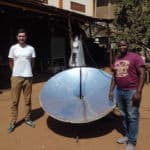Finding Opportunity in a Crisis: How Hatch Technologies Started a New Medical Device Venture During a Global Pandemic
By July 2020, the global COVID-19 pandemic was spreading aggressively across Africa, with nearly half a million cases in 54 countries. That is the very same month that our organization, Hatch Technologies, launched. As a nonprofit supporting newborn medical device distribution and services in sub-Saharan Africa, it was clear from the beginning that the tasks ahead for our fledgling organization would take place in one of the most financially and logistically challenging times the world has experienced.
Just as we started our operations, hospitals across Africa were facing unprecedented hurdles, including shortages of medical supplies and personnel. Medical device distribution networks also suffered limitations due to travel and supply chain disruptions. On top of that, banks were restricting their lending, making it impossible for local medical device distributors to access the credit needed to purchase these devices. Newborn care units were hit especially hard: COVID-related shortages in oxygen tanks were forcing hospitals to divert these resources outside the newborn units, putting delicate new lives at risk.
While we watched these events unfold during the first wave of the pandemic in Africa, we realized that it was more important than ever to launch, learn and grow Hatch as quickly as possible to assist our partners in their lifesaving work. The continent’s neonatal units desperately needed support in procuring, using and maintaining essential equipment, and Hatch was poised to provide it.
Shoring up medical device distribution during a pandemic
As the common adage goes, “A journey of a thousand miles begins with a single step.” Hatch swiftly started taking those steps by establishing our operations in Kenya and quickly expanding them to serve hospitals in Tanzania and Nigeria. We recognized that Hatch had the contacts to procure scarce equipment, deliver it, and make sure there were devices available for both newborn units and general hospital use. It was important to us to maintain equipment for our primary objective, supplying newborn units, while also helping our country partners respond to the increased need for equipment hospital-wide.
We leveraged our relationships with local distributors to work past some of the supply constraints brought about by the pandemic, ensuring newborn units and hospitals were receiving oxygen concentrators, pulse oximeters, infrared thermometers and suction machines. In July and August, we made deliveries and worked to facilitate the successful installation and maintenance of all these devices. Despite global supply chain constraints, over our first year in operation, Hatch installed over 850 medical devices across four of our phase-one countries – Kenya, Tanzania, Malawi and Nigeria.
Financing medical equipment when banks pull back
Even before the pandemic, Hatch was focused on the lack of easy credit access for African hospitals. This limitation only became more pronounced during COVID-19, when the credit providers that our hospital partners rely upon to purchase equipment in bulk virtually disappeared due to the economic fallout of the crisis.
Our pre-pandemic work on securing local financing mechanisms helped us quickly find international financial institutions and global development organizations that could support medical equipment distributors when banks could no longer help. This is not a short-term fix: We are continuing to develop solutions to the financing limitations that are still present in the markets in which we work. These efforts are vital to supporting the equipment purchasing required not only for the COVID-19 response, but for ongoing quality newborn care.
Ensuring medical equipment is fully functional
We know that functioning medical equipment saves lives, but too often this equipment becomes part of the 40% of unused, often non-functional medical devices in an equipment graveyard. To avoid this, we developed a customer support system that monitors each neonatal technology we source, and reports its functional time to a centralized dashboard. Using our dashboard, we can proactively reach out to hospitals about devices that are not in use, to see if there is a need for training or repair.
By identifying issues when they arise, we are able to respond quickly and send an engineer to address the problem within 48 hours — this quick response is key to keeping lifesaving equipment available for clinicians. The 850+ devices we installed in our first year have been reporting a 95% uptime through our dashboard.
Providing know-how to clinicians and technicians
After a medical device has been installed within the Hatch network, we work with NEST360 to train clinical staff on how to use the technology appropriately, and also to train hospital technicians on how to service and maintain the device. This training partnership ensures that staff have the know-how to use and repair equipment, making it useful for saving the lives of small and sick newborns. We are impressed by the resilience of the NEST360 partnership, as the organization quickly pivoted to train people remotely due to the limitations of COVID-19.
Despite the obstacles we’ve faced, the pandemic proved to be an opportune time to launch a new venture. Innovation arises from great challenges, and the journey ahead is exciting. Over the next five years, Hatch, using a social enterprise model, plans to scale our commercial activities in Kenya, Nigeria, Tanzania, Malawi and several other African countries. Through this effort, we aim to completely reform the neonatal medical device market in low-resource settings, make it an attractive space for medical device manufacturers, and help hospitals and countries end preventable newborn deaths.
Dick Oranja is the Executive Director of Hatch Technologies.
Photos courtesy of Dominic Chavez/World Bank and Dominic Chavez/The Global Financing Facility.
- Categories
- Coronavirus, Health Care





